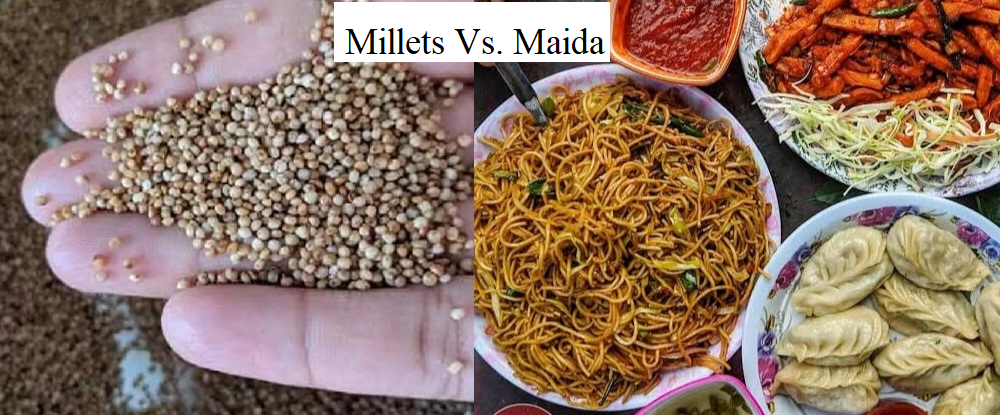PM Modi making global pitch for Millets but kids in India addicted to Burgers, Pizzas & Noodles !

PM Modi making global pitch for Millets but kids in India addicted to Burgers, Pizzas & Noodles !
Parents having a tough time in convincing the kids
The Delhi Crown
New Delhi, Jan. 1: For the past few years Prime Minister Narendra Modi has been making a strong pitch for Millets (Bajra, Jowar, Ragi etc.) in a bid to promote their nutritional value and also combat hunger and malnutrition in the country and globally. But on the other hand the country’s younger generation (in the age group of 5-25 years) is more attracted towards fast-foods made of Maida such as Burgers, Pizzas & Noodles.
Millets are a known rich source of Protein, Fibre, Minerals, Iron, Calcium and have a low Glycemic Index (a value used to measure how much specific foods increase blood sugar levels), whereas Maida is a refined form of wheat-flour sans fibre or bran.
Health experts warn that excessive consumption of Maida can damage several organs and the digestive system in the human body. Maida digestion-time can be anywhere from 24 to 72 hours. It’s a fact that consuming too much of Maida-made products may lead to diseases like diabetes, PCOS and obesity, besides making humans feel sluggish.
Traditionally Maida was used in Indian households for cooking delicacies on festivals or other functions like marriages etc. Or, in other words, not more than 3-4 times in a year. But, now eating Maida-made dishes have become a daily/routine affair, particularly amongst the younger generation. They are in fact addicted to Maida-made fast foods like fried Burgers, Pizzas, Noodles, Bread-Sandwiches, Momos, etc.
Parents not only in urban areas and cities, but in remote areas and villages too, are fed up with their modern-day kids’ eating choices. Today one can easily find street-vendors selling Chowmein (Noodles), Momos, Kathi Rolls, fried Burgers, etc. in small towns and remote villages as well. The covering of Kathi Rolls is customarily made of Maida.
Parents in the age group of 45-55 are facing a tough time in making their kids understand the disadvantages of eating such food items and cut down on their consumption. But in vain, even as the business of street-food vendors selling these items continues to flourish in the country like never before.
In most households where the parents and grand-parents choose eating Bajre-ki-Roti especially during winter months, their younger ones raise hate-eyebrows, making ugly faces describing it as a chapatti made of Cement and shun the idea of even touching it…! And, prefer ordering their favourite fast-foods mentioned above! The story is the same from households in cities and villages as well.
The UN General Assembly has declared 2023 as the International Year of Millets (IYM). Marking the first day of IYM, India’s Ministry of Agriculture & Farmers Welfare on Sunday (Jan. 1) issued a press release highlighting the focused activities being undertaken by Central Ministries, State Governments and Indian Embassies across the globe.
The Department of Agriculture & Farmers Welfare has taken a proactive multi-stakeholder engagement approach (engaging all the central government ministries, states/UTs, farmers, start-ups, exporters, retail businesses, hotels, Indian Embassies etc.) to achieve the aim of IYM 2023, and taking Indian millets globally.
Ministries, states and Indian embassies have been allocated focussed months in 2023 to carry out various activities for promotion of IYM and increase awareness about benefits of millets for the Consumer, Cultivator and Climate.
Millets were among the first crops to be domesticated in India with several evidence of its consumption during the Indus valley civilization. Still it is considered as a traditional food for more than half a billion people across Asia and Africa.
In India, Millets are primarily a Kharif crop, requiring less water and agricultural inputs than other similar staples. They are important by the virtue of its mammoth potential to generate livelihoods, increase farmers’ income and ensure food and nutritional security all over the world.





